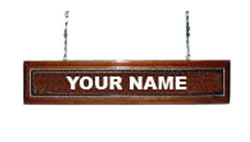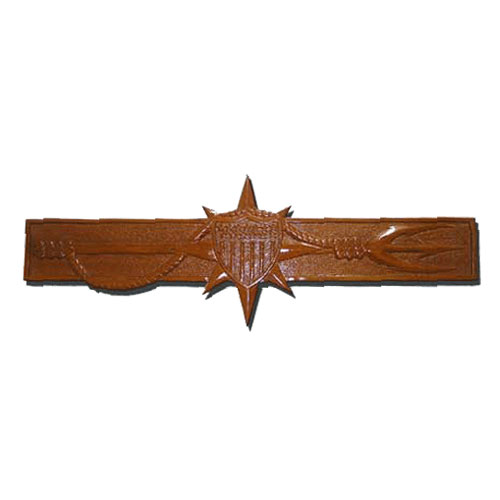Description
Military Wings and Insignia Plaques |
|
Made from solid mahogany all of our military wings and insignia are hand carved and finished by our expert craftsmen. The mahogany is cured and treated at our own factory to avoid warping and twisting over the years and a special keyhole slot is recessed into the rear to ensure a flush fitting on ay wall surface. It is impossible to list all the different designs that we have made over the years so if you do not see exactly what you want, please do not hesitate to call our support staff or send us an email using the contact option on the bottom of the page.This set of wings makes an ideal present, retirement gift or addition to your memorabilia collection. They look great on your office wall or in the den at home. We make seven standard sizes but if you have a special size that you want we can custom build it for you with no set-up or design costs.A name plate can be added to the underneath of the wings as shown below for a small amount extra. The name plate is fixed to the bottom of the wings by a chain and makes a wonderful way to personalize this item. If urgency is an issue we can offer an express 14 day delivery for the extra fee shown. Our staff have been specially trained to help you with any questions or design issues that you might have. Call us toll free on 1-877-543-6094. Delivery Time: the normal delivery time is approximately four to six weeks, however we offer a 14 day express service, just select the plaques size above in the Express Delivery Option. Size: If the size you want to order is not shown above, please call us or send a priority message by clicking here. Approval: Prior to shipment you will be sent a high resolution picture of your plaque for your approval. Assistance: You can use the Live Support option on the left or call us direct on Toll Free 1-877-543-6094. Custom Wings and Insignia: We can offer you a complete custom service if you do not see what you are looking for. We can take your artwork in most popular formats or we may even have your design in our extensive military library. For assistance by phone please call our Toll Free Number 1-877-543-6094. To order by phone or for more information about this product call 1-877-543-6094 |
The Association Of Aviation Ordnancemen AAO Wings Plaque |
|
The Navy’s Aviation Ordnance Rating The Navy accepted its first aircraft, a Curtiss Triad (Hydroplane), on August 9, 1911. Early bombing tests were held in January and February of 1913, at Guantanamo Bay, Cuba, and in July 1914 at Indian Head, Maryland. Twenty-two months later, in May 1916, the development of a gyroscopic bomb-sight was initiated. On April 6, 1917, at which time the United States entered into World War One, the inventory of the fledging air arm consisted of the following: 45 seaplanes, six flying boats, three land planes, and one airship. By September, 1917 two types of bombs were in service with a third type coming into production, weighing 163, 270, and 216 pounds respectively. Successful tests of machine guns were conducted between January and May, 1918 at Pensacola, Florida. In March of 1918, the Aviation Ordnance (AVORD) sub-section in the Bureau of Ordnance, became a separate unit. Previously it served as a division of the Surface Gun Mount section, dating back to the early months of the war. As a separate group, they were given cognizance over the procurement and technical aspects of machine guns, including mounts, sights, fittings and ammunition. Other aviation ordnance items falling within AVORD cognizance in 1918 were larger caliber guns, bombs, bomb racks, bomb sights, pyrotechnic signaling devices, air launched torpedoes, aircraft torpedo launching equipment, and training devices which include miniature practice bombs. The USMC Aviation Ordnance Rating In an effort to establish a date as the birthday for Aviation Ordnance it is necessary to back up and look for a moment at the history of Marine Aviation. The idea of Marine Aviation dates, perhaps, from the year 1903, when a young Alfred Austin Cunningham first watched a manned ballon fly and talked its owner into giving him a ride. A year later Cunningham entered the U.S. Naval Academy, graduating in 1909 and chose to become a second Lieutenant in the Marine Corps. He was continually obsessed with flying and after stirring a congressional tempest, was ordered to the Navy’s Aviation camp at Annapolis for flight training on 22 May 1912. There he became the Marine Corps first aviator and Naval aviator number 5. From that date until WW I, Marine aviation was small. Starting with only five officers and thirty enlisted men on the day the United States declared war, the Marines increased their air arm until the close of the war they had 282 officers and 2180 enlisted men. In the two decades that followed WW I Marine Aviation went into Haiti, the Dominican Republic and Nicaragua. It was during this era that Aviation Ordnance was finally identified as a separate skill. The document that did this was a Table of Organization (T/O). To understand just how a Table of Organization could establish a skill, it is necessary to trace backwards from the present system of Military Occupational Specialties. Marine AO’s are currently known as Aviation Ordnance with occupational field 65. This has only been true since 1949. From 1942 to 1949 all Marines were identified by their Specification Service Numbers (SSN’s). Enlisted ordnancemen were (SSN 991’s). Prior to 1942 and through the years Marine Aviation was emerging, the Marine Corps identified their enlisted men through their promotion certificates which were then called Branch Warrants. Upon graduating from boot camp and until a man was promoted to Corporal he was a Marine with no identifiable skill. On promotion to Corporal there would appear on the Warrant the words “Corporal” (Aviation). The term “aviation” designated his branch. There was no further break down. The number of branches in the Marine Corps varied from time to time but generally included such specialties as Aviation, Communications, Engineers, Motor Transport, Ordnance (ground), Artillery and the Infantry (line). To further identify the skill of a Marine it was necessary to look at the T/O and see what slot the man was filling. The First Aviation T/O’s were issued about 1918 and showed only six kinds of personnel, Motor Shop, Erection Shop, Quartermaster, Transportation, Mess and Police. It wasn’t until Table of Organization No. 37 was issued on 25 April 1922 that ordnance appeared on a T/O, and when it did, the term used was Gunnery personnel. This T/O authorized one Warrant Officer, one Sergeant, one Corporal and one PFC for a Division Aviation. They were assigned six airplanes. The name Gunnery personnel stayed until Table of Organization No. 43-W was published on 11 September 1925 when the name was changed to Armament personnel. At this time the personnel allowance for a squadron was increased to 3 Marine Gunners, 3 Sergeants, 3 Corporals, and 3 PFC’s. This remained in effect until 6 February 1935 when Table of Organization No. 23 changed the name to Ordnance. This authorized an Ordnance strength of one First Lieutenant, One Marine Gunner, one Master Technical Sergeant, one Sergeant, one Corporal and 3 PFC’s/Privates. Since that day the title has stayed the same, only the method of identifying us has changed. Taken from an article written by G. H. CONNER,Capt USMC |







Reviews
There are no reviews yet.